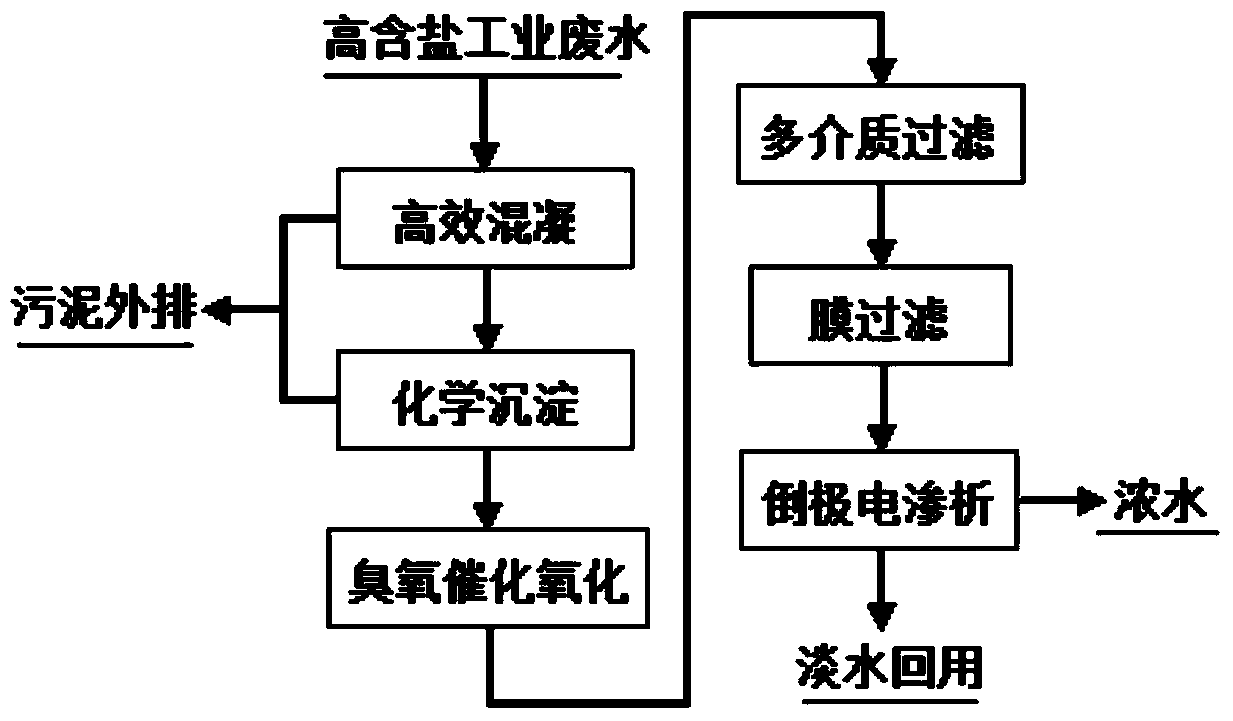Method for deeply treating, desalting and recycling industrial wastewater with high salt content
A technology for industrial wastewater and advanced treatment, applied in water/sewage multi-stage treatment, water/sludge/sewage treatment, chemical instruments and methods, etc., can solve the problems of large discharge of concentrated water, serious membrane pollution, and huge equipment. , to achieve the effect of good removal effect and high catalytic oxidation efficiency
- Summary
- Abstract
- Description
- Claims
- Application Information
AI Technical Summary
Problems solved by technology
Method used
Image
Examples
Embodiment 1
[0039] Example 1 Direct Electrodialysis Desalination of Salt-Containing Wastewater from Coal Chemical Industry
[0040] Although the salty wastewater of coal chemical industry meets the discharge standard of COD and ammonia nitrogen, due to the Cl - Inorganic salts such as ions, a small amount of refractory organic matter, suspended particulate matter and bacteria, etc. limit their recycling, and further removal of Cl - Inorganic ions and other pollutants. Electrodialysis technology is used for desalination treatment, constant potential operation is used, both concentrated water and fresh water are filtered with 5μm filter element, and then electrodialysis is used for desalination.
[0041] After 10 batches of continuous desalination experiments, it was found that the Cl in the fresh water of the initial batch of desalination experiments - The ion energy quickly drops below 250mg / L to meet the reuse standard. However, in each batch of experiments, the current density showed...
Embodiment 2
[0042] Embodiment 2 Advanced treatment and desalination reuse of salty wastewater from coal chemical industry
[0043] According to the water quality characteristics of the coal chemical wastewater containing salt, high-efficiency coagulation—chemical precipitation—ozone catalytic oxidation—multimedia filtration—precise filtration—membrane filtration, etc. are used to pre-remove bacteria, suspended particles, Colloids, macromolecular organics, Ca 2+ and Mg 2+ and other high-valent ions, etc., and then use inverted electrodialysis to remove soluble inorganic salts in wastewater. Among them, when high-efficiency coagulants are used to treat high-salt industrial wastewater, the removal rate of organic matter in wastewater can reach 30-50%, and cyanide can reach more than 90%; then NaOH and soda ash are added for chemical precipitation to remove Ca in wastewater. 2+ and Mg 2+ and high-valent ions, etc., to reduce the concentration of these ions to below 50mg / L; carbon-based com...
PUM
 Login to View More
Login to View More Abstract
Description
Claims
Application Information
 Login to View More
Login to View More - R&D
- Intellectual Property
- Life Sciences
- Materials
- Tech Scout
- Unparalleled Data Quality
- Higher Quality Content
- 60% Fewer Hallucinations
Browse by: Latest US Patents, China's latest patents, Technical Efficacy Thesaurus, Application Domain, Technology Topic, Popular Technical Reports.
© 2025 PatSnap. All rights reserved.Legal|Privacy policy|Modern Slavery Act Transparency Statement|Sitemap|About US| Contact US: help@patsnap.com

